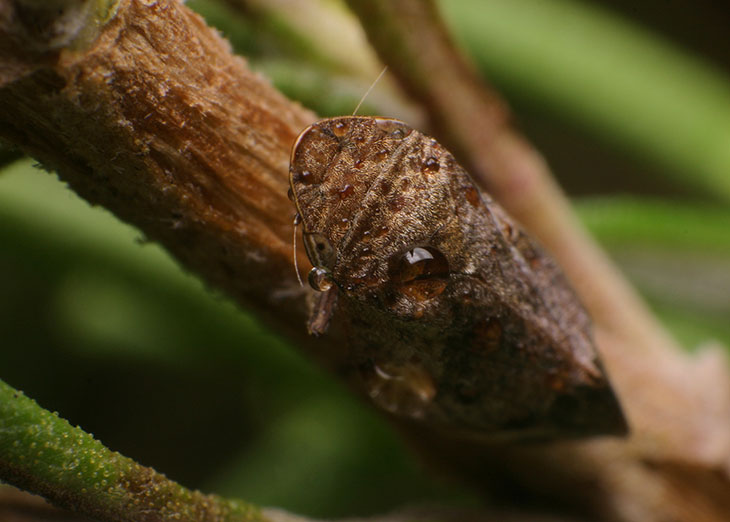
I got out the camera to chase a particular subject, which disappeared on me, so while the strobe was still charged I decided not to waste that electricity and went looking for something else to photograph. Yeah, I really do think that way sometimes, though if I do find another subject, I’ll fire off a lot more frames (and flashes) than if I simply discharged the capacitor before putting the strobe away. However, the power didn’t go to waste, so calculate that any way that works for you.
Above, an angular spittlebug (Lepyronia angulifera) relies on its camouflage, in vain, while waiting out the recent saturating rains on the rosemary bush. You’re looking down on top of the head from the nose-end of the insect, and just behind the antennae you can make out the compound eyes breaking pattern, one of which sports a raindrop at its rear corner. The insect would look almost exactly like a new bud, except rosemary doesn’t grow that way.
I had initially identified this an a diamondback spittlebug (Lepyronia quadrangularis,) a variety of leafhopper, but now believe I was wrong, based on the slope of the head. Curiously, the images on BugGuide.net that convinced me of this were taken by my photographer friend back when he lived in this area – should have known he’d have images of the species. This was the only angle I could manage, and the specimen catapulted away when I tried to nudge it into a different position, so here are a couple of images of one from earlier this year, to give a better idea of the shape.
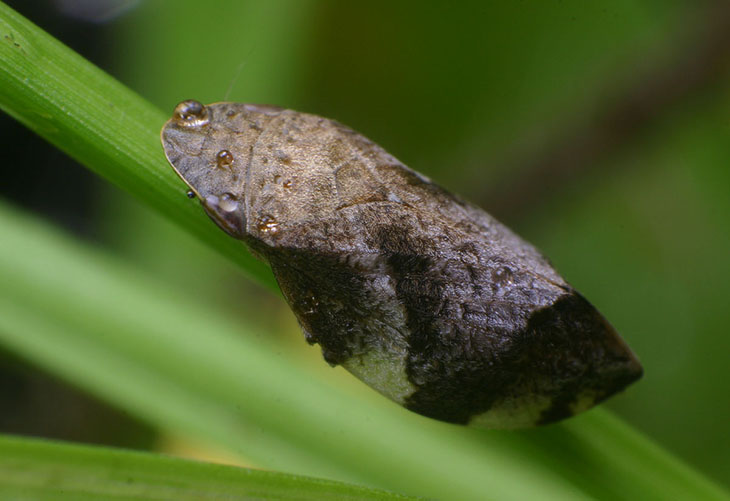
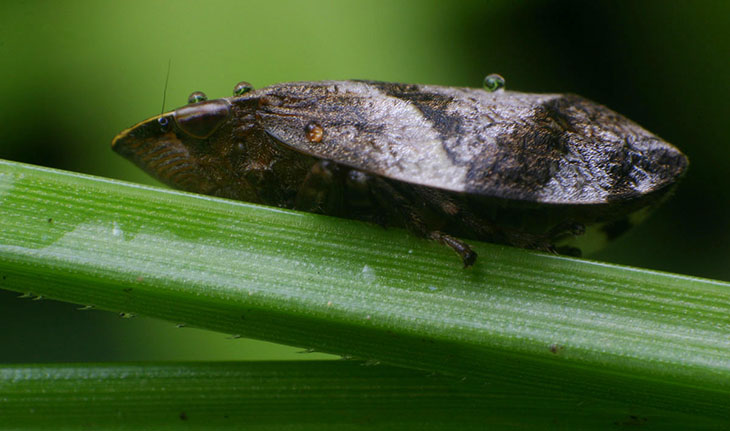
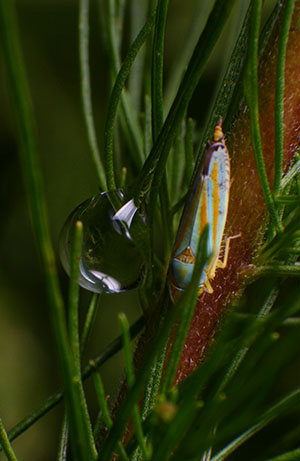 Do you get the impression that their exoskeleton is good at repelling water? It’s actually incredibly good – they coat themselves with an internally-produced substance called brochosomes, microscopic soccer balls that exploit water’s surface tension to prevent adhesion. Definitely check out that article, because it also talks about why leafhoppers, alone among so many insect classes, should do this; it’s the lack of toilets.
Do you get the impression that their exoskeleton is good at repelling water? It’s actually incredibly good – they coat themselves with an internally-produced substance called brochosomes, microscopic soccer balls that exploit water’s surface tension to prevent adhesion. Definitely check out that article, because it also talks about why leafhoppers, alone among so many insect classes, should do this; it’s the lack of toilets.
Earlier this year I featured a post on sharpshooters, leafhoppers that fling their feces away without even the benefit of hands, making them the envy of most monkeys. But not every member of the Cicadoidea has a bowel-cannon, though most may have equally sticky excrement. To prevent coating themselves with their own copiously-produced ka-ka, they kryptonite themselves first with brochosomes – we have to wash our hands after communing with nature, but they have to wash their entire bodies before (you are welcome to use that to convince your kids they have it easy, if you think it’ll help.) Yes, this means they are one species which can brag that their shit doesn’t stick.
One could ask why wouldn’t they have feces that isn’t sticky? If they have to produce a completely separate substance that then has to be applied manually to their external surfaces, wouldn’t it have been more efficient to, perhaps, produce feces in the same manner as the brochosomes? But this is a perspective that almost assumes planning, which is entirely the wrong way of viewing it. Evolution often involves repurposing an existing trait or function. Numerous species exude one substance or another to protect their exoskeleton, skin, or feathers, often requiring it to be distributed by ‘instinct,’ and many insects already have habits to clean themselves of dirt, oils, or parasites; it’s not a huge jump to combining and/or changing these two traits for leafhoppers. The alternative is to change their digestive structure so the feces comes out in different form – for leafhoppers, their digestion is remarkably quick, since they pull very little from the sap as nutrition, expelling the rest. A system that changed the expelled sap so distinctly would not only slow down this process, it would take energy of its own, and likely require repurposing something else within the alimentary canal of the insect.
And then, there’s just the luck of the draw. Natural selection doesn’t produce any changes on its own – it simply works with changes that occur (more or less) randomly. If Gland A changed in a slightly more beneficial way before Organ B could, that’s what gets selected and incorporated into the species’ repertoire, though Organ B might have done it much better. Then, even if Organ B does later change, it would have to impart its own significant benefit over and above what Gland A does for selection to even act upon it. This is why ‘design’ is such a stupid concept to apply to nature, since what we see everywhere are actually examples of modified structures forced to do the job.
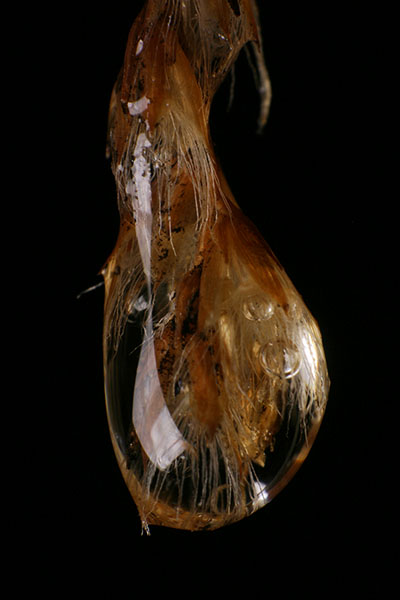 I hadn’t originally intended to include most of that above – it came from suddenly recalling Ed Yong’s article while thinking about those water drops. What was intended was to include this other image from the same photography session, a lone raindrop hanging from the tip of the dog fennel flowers (see here for a shot of ‘typical’ perspective.) This was taken at night, freehand, the one frame I attempted, since there remained a slight breeze and the long arc of the stalk was drifting around under its direction. This is the exact same magnification as the top photo, so go back and look at that, paying attention this time to how short the range of sharp focus is – if it helps, the foreground stalk at bottom left is a rosemary leaf, and the whole insect is less than 4mm wide. Get the idea? Good. So when I tell you that this water drop was wandering several centimeters unpredictably right at eye-level, and I waited for it to come into focus range, you might realize just how precise the timing had to be. Luck had a lot to do with it, trust me – there’s a reason I only tried one frame before giving up the attempt for better conditions. I occasionally spend a lot of time trying to set up a particular shot and never achieve the result I was after, so getting this image so sharp on what was a casual, throwaway effort is a little ironic. But I’ll take it anyway.
I hadn’t originally intended to include most of that above – it came from suddenly recalling Ed Yong’s article while thinking about those water drops. What was intended was to include this other image from the same photography session, a lone raindrop hanging from the tip of the dog fennel flowers (see here for a shot of ‘typical’ perspective.) This was taken at night, freehand, the one frame I attempted, since there remained a slight breeze and the long arc of the stalk was drifting around under its direction. This is the exact same magnification as the top photo, so go back and look at that, paying attention this time to how short the range of sharp focus is – if it helps, the foreground stalk at bottom left is a rosemary leaf, and the whole insect is less than 4mm wide. Get the idea? Good. So when I tell you that this water drop was wandering several centimeters unpredictably right at eye-level, and I waited for it to come into focus range, you might realize just how precise the timing had to be. Luck had a lot to do with it, trust me – there’s a reason I only tried one frame before giving up the attempt for better conditions. I occasionally spend a lot of time trying to set up a particular shot and never achieve the result I was after, so getting this image so sharp on what was a casual, throwaway effort is a little ironic. But I’ll take it anyway.




















































